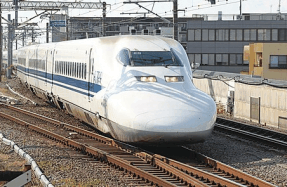
In 1934 the Chicago, Burlington & Quincy Railroad introduced a revolutionary train, the Zephyr, which kicked-off the streamlined era on US railroads. This was a unidirectional articulated set comprising a diesel-engined power car, a passenger car and an observation car, all with lightweight stainless steel bodies built using the ‘shot weld’ process. The builder was the Budd company of Philadelphia and after the war the company used this technology to produce a lightweight powered car which could be run in either direction or in multiple – the Rail Diesel Car (RDC). Powered by General Motors 6-cylinder diesel engines, a total of 398 RDCs in various configurations were built between 1949 and 1962. Many were exported, of which 116 went new or second-hand to railways in Canada for service on the Canadian Pacific (CP), Canadian National (CN) and Pacific Great Eastern (PGE) Railways. CP branded their RDCs ‘Dayliners’ but they were often simply referred to as ‘Budd Cars’. The design has proved to be successful and long-lived, with VIA Rail inheriting a substantial fleet when it took over most Canadian passenger operations from 1977.
A visit to British Columbia (BC) in April 1976 gave me the opportunity to travel by Budd Car on scheduled passenger services on two different railways, and I was fortunate that the weather was fine and sunny on the days concerned as in both cases there was heavy rainfall the next day. My first journey took place during a week staying with friends in Victoria, the state capital, a port city at the southern tip of Vancouver Island. The island is about 283m (467km) in length with a maximum width of 62m (100km) and is dominated by a rugged mountain range along the western side. The main settlements are on the lower ground in the coastal areas of the south and east, which are dissected by canyons cut by rivers flowing from the mountains. The earliest railways were short industrial lines built from the 1860s to link collieries in the Nanaimo area with coastal water for onward transit. Other mining lines followed, and later there were numerous lines built around the island by the logging companies to exploit the forests and reach coastal water. From the late nineteenth century an alternative outlet was via public railways as these were developed. The longest of the public lines was that of the Esquimalt & Nanaimo Railway (E&N) which served the east coast north from Victoria (Esquimalt was a naval base to the west of the city). A CP lease of the line was ratified in 1912. The Canadian Northern Pacific Railway, which was taken over by CN in 1918, built a smaller network in the south, but all passenger services had ceased by 1931. On the E&N, passenger services ran north from Victoria to Courtenay with a branch from Parksville to Port Alberni; a branch from Hayward to Cowichan Lake carried mainly logging traffic but also had a short-lived passenger service. In 1949 the E&N became the first part of CP to be dieselised and in 1955 a Budd RDC arrived to work the Victoria – Courtenay trains, with a single weekday return service cutting the journey time by over a third. The Port Alberni passenger service was withdrawn.






